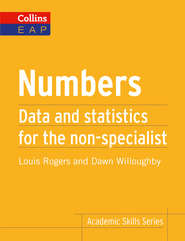скачать книгу бесплатно
Numbers: B2+
Dawn Willoughby
Louis Rogers
Statistics and data for the non-specialist*The Collins Academic Skills Series - winner of the ELTon 2014 Innovation in Learner Resources Award.*At university you may be expected to analyse complex data and present your findings, whatever your area of study. Collins Academic Skills Series: Numbers gives you the skills you need to make sense of data and numbers and the confidence to use them effectively in your work.Learn how to• interpret statistics and data• conduct surveys• evaluate and question results• present numerical information clearlyCollins Academic Skills Series: Numbers will help you to make the most of your time at university.• Clear information and practical exercises• Information on academic expectations – understand the requirements of studying at university• Helpful tips and summaries• Answer key and glossaryNumbers is part of a new six-book series to help international students achieve academic success at college or university. It is designed to support students who are studying, or preparing to study, at an English-speaking institution.Suitable for students whose level of English is Upper Intermediate / CEF level B2 / IELTS 5.5 and higher.Other titles in the Collins Academic Skills Series:Group Work • Lectures • Presenting • Writing • Research
Collins (#ulink_b55acb4b-5349-5da2-baeb-3b0be120c2ca)
HarperCollinsPublishers 77-85 Fulham Palace Road Hammersmith London W6 8JB
www.harpercollins.co.uk (http://www.harpercollins.co.uk)
First edition 2013
© HarperCollins Publishers 2013
Collins
is a registered trademark of HarperCollins Publishers Limited
www.collinselt.com (http://www.collinselt.com)
A catalogue record for this book is available from the British Library
All rights reserved under International and Pan-American Copyright Conventions. By payment of the required fees, you have been granted the non-exclusive, non-transferable right to access and read the text of this e-book on screen. No part of this text may be reproduced, transmitted, downloaded, decompiled, reverse engineered, or stored in or introduced into any information storage and retrieval system, in any form or by any means, whether electronic or mechanical, now known or hereinafter invented, without the express written permission of HarperCollins.
HarperCollinsPublishers has made every reasonable effort to ensure that any picture content and written content in this ebook has been included or removed in accordance with the contractual and technological constraints in operation at the time of publication.
HarperCollins does not warrant that www.collinselt.com (http://www.collinselt.com) or any other website mentioned in this title will be provided uninterrupted, that any website will be error free, that defects will be corrected, or that the website or the server that makes it available are free of viruses or bugs. For full terms and conditions please refer to the site terms provided on the website.
If any copyright holders have been omitted, please contact the Publisher who will make the necessary arrangements at the first opportunity.
You can trust Collins COBUILD
The 4.5-billion-word Collins Corpus is the world’s largest database of the English language. It is updated every month and has been at the heart of Collins COBUILD publishing for over 20 years. All definitions provided in the glossary boxes in this book have been taken from the Collins COBUILD Advanced Dictionary.
Source ISBN: 9780007507153
Ebook Edition © April 2014 ISBN 9780008101848
Version: 2014-07-01
Contents
Title Page (#u67c88dfa-2ecc-5f02-a33d-e251dc67759c)
Copyright (#ue45b060d-c031-53ed-9c77-3749c49db958)
Introduction (#ub83f7cde-9273-519a-a9fe-4147506d7578)
Chapter 1 Getting started (#u3799d65a-9258-5ee7-b7c0-e9a46035ec4b)
look at numbers in everyday life
understand the purpose and use of statistics
learn key terms for working with numbers
learn the basics about spreadsheets
practice referring to and labelling graphics in writing
Chapter 2 Starting primary research (#ufaeb31f1-ac0c-5871-9a0b-9619d8aa91d1)
practise formulating research questions
understand the principles of sampling
learn how to formulate a hypothesis
Chapter 3 Research methods (#udb663fdc-bdaa-57c3-a6ec-001ec0d1efae)
understand some common research methods
understand when to use interviews, questionnaires and focus groups
understand the advantages and disadvantages of common research methods
Chapter 4 Questionnaires (#litres_trial_promo)
understand how to write a questionnaire
practise forming polite question forms
understand different sampling techniques
understand the pros and cons of distribution methods
Chapter 5 Interviews (#litres_trial_promo)
understand how to ask good interview questions
learn how to structure different questions
learn about the interviewer effect
learn how to use reported speech
Chapter 6 Percentages and fractions (#litres_trial_promo)
learn how to work with percentages
learn how to understand fractions
compare fractions and percentages
use verbs and nouns and dependent prepositions
Chapter 7 Averages (#litres_trial_promo)
learn why we use averages
learn about different types of averages
learn when to use frequency tables to find averages
learn how to choose the right average to use
Chapter 8 Presenting your data (#litres_trial_promo)
understand the use of different visual information
use the present simple, past simple and present perfect to describe graphics
use the active and passive voice to describe graphics
Chapter 9 Describing change (#litres_trial_promo)
represent change visually
use verbs of change
use adverbs describing change
use adjective and noun combinations to describe change
Chapter 10 Making comparisons (#litres_trial_promo)
use graphics to compare information
use comparative structures
use superlative structures and cautious language
Chapter 11 Making connections (#litres_trial_promo)
understand correlation
understand the effect of sample size
express links and connections
describe facts and data
Chapter 12 Working with collected data (#litres_trial_promo)
learn how to present survey results
avoid producing misleading results from diagrams
describe cause and effect
express generalizations and specifics
use language of argumentation
use evaluative language
learn how to write conclusions
Further reading (#litres_trial_promo)
The grammar of fractions (#litres_trial_promo)
Glossary
(#litres_trial_promo)
Answer key (#litres_trial_promo)
About the Author (#litres_trial_promo)
About the Publisher (#litres_trial_promo)
Introduction (#ulink_ac99a9cf-ae8e-5583-bfd5-cac0479ebcba)
Collins Academic Skills Series: Numbers will give you the skills you need for doing research, collecting data, presenting it, using numbers and appropriate language to describe it, and working with the collected data.
Designed to be used on a self-study basis to support English for Academic Purposes or study skills courses, it is intended for students on pre-sessional or foundation courses as well as for first-year undergraduate students.
The book has twelve chapters covering the key stages of the research process from start to finish. You will learn how to:
choose the right research methods
use basic maths skills
present your data
analyse your data
